GC Secretary Calls Leaders to Redouble Efforts, Tackle Challenges in the Mission Field
Erton Köhler discusses windows of opportunity for committed Adventist missionaries.
October 14, 2024 | Silver Spring, Maryland, United States | Marcos Paseggi, Adventist Review
A review of a recent mission trip set a singular tone for the Secretariat Report at the Annual Council of the General Conference of Seventh-day Adventists (GC) in Silver Spring, Maryland, United States, on October 13.
The report would be “a precious time to share with you a picture of our church and its worldwide mission,” GC secretary Erton Köhler told the more than 300 attending members of the Executive Committee (EXCOM). Köhler and his team reported church growth and other figures but went beyond statistics to review the genesis of Adventist mission to the world, discuss the current state of missionary deployment, and share some of the possibilities and challenges for the months and years ahead. Köhler began with the testimony of a departmental mission trip to Cuba.
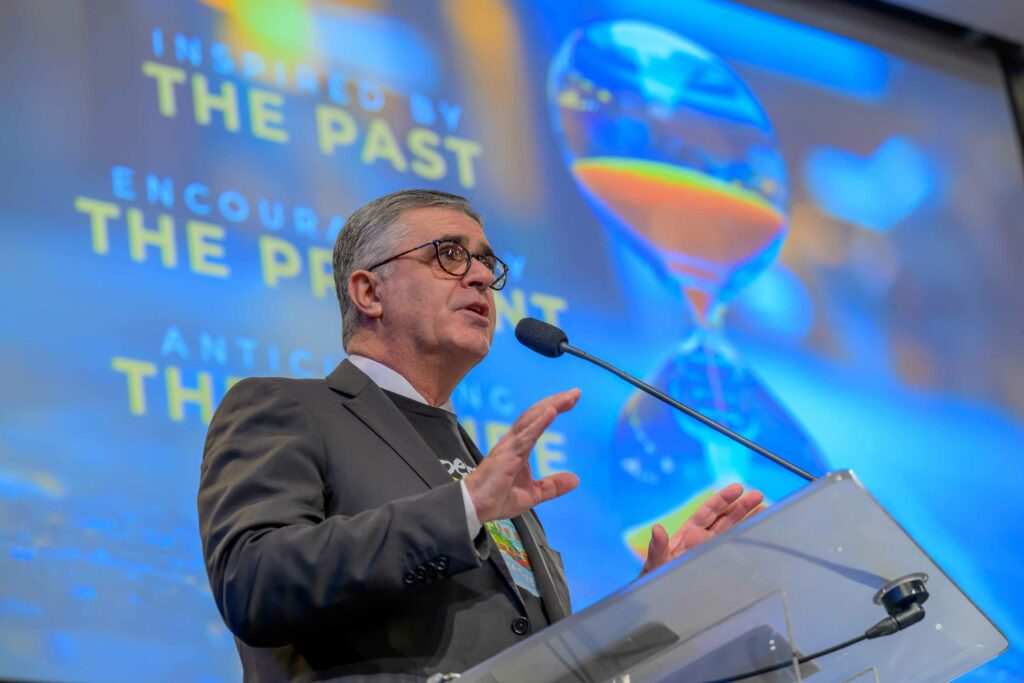
General Conference secretary Erton Köhler presents his report to the members of the Executive Committee in Silver Spring, Maryland, United States, on October 13. [Photo: Tor Tjeransen / Adventist Media Exchange (CC BY 4.0)]
Köhler described how, in a first, almost 30 leaders and workers serving in the GC Secretariat office at the Adventist Church’s headquarters participated in a mission trip to Cuba in late July and early August. The initiative combined the efforts of the GC, the Inter-American Division, and the Cuban Union Conference (CUC). Secretariat also enlisted a partnership with Maranatha Volunteers International, a supporting ministry of the Adventist Church.
Köhler shared how “Hope for Cuba” included five evangelistic reaping campaigns that resulted in 76 baptisms and 217 enrolled in Bible studies. A special project also benefited more than 300 children, he reported.
Through a combined effort of all entities and bodies involved, church leaders donated five video projectors to be used in evangelism, supported the planting of two new churches, and helped repair and paint one church in Havana, Köhler shared. GC Secretariat also donated a new van for the CUC, after the only vehicle the field owned had accumulated more than 650,000 miles (more than 1 million kilometers).
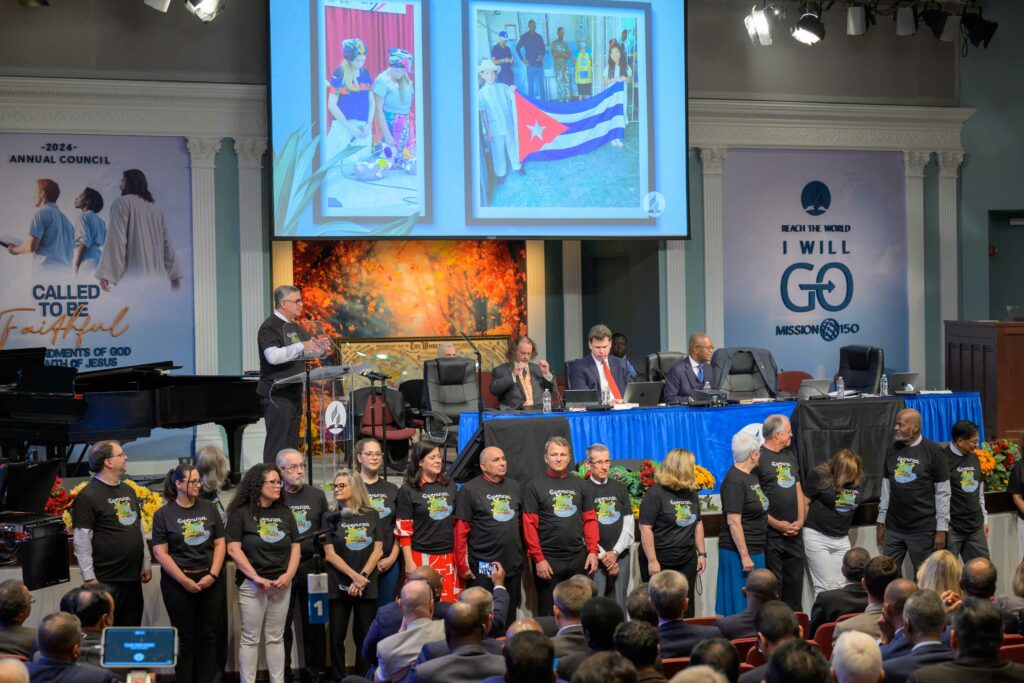
Part of the staff of the General Conference Secretariat that participated in the Hope for Cuba mission trip in late July and early August. [Photo: Tor Tjeransen / Adventist Media Exchange (CC BY 4.0)]
What Member Statistics Show
Accessions to the Adventist Church have fully rebounded after the challenging circumstances of the COVID-19 pandemic, according to David Trim, director of the GC Office of Archives, Statistics, and Research. In 2023, the church welcomed more than 1,465,000 new members — more than 4,000 a day, or one every 21.5 seconds. “In fact, 2023 saw the largest number of net accessions of any year in Adventist Church history,” Trim said.
At the same time, more than 836,000 left the denomination in 2023 (excluding deaths), the third highest figure ever recorded. “The four highest losses have been in the last five years,” Trim reported. Thus, he added, “accessions alone do not count for church growth. We have to find ways to disciple [sic] more members if we want our net growth to become more explosive.” Currently, the percentage of members who leave is closer to 43 percent, he reported.
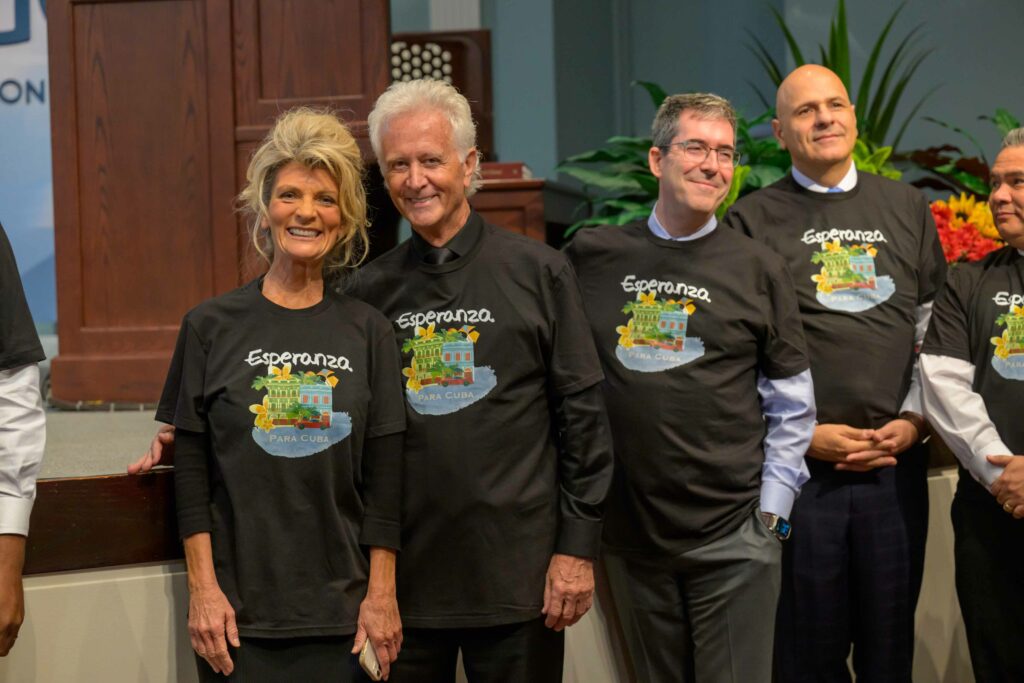
Maranatha Volunteers International leaders (from left to right) Laura Noble, Don Noble, and Kenneth Weiss smile during a recognition ceremony for their contribution to the Hope for Cuba mission initiative. [Photo: Tor Tjeransen / Adventist Media Exchange (CC BY 4.0)]
Trim also shared that globally, 30 church members are needed to produce one accession. It’s a statistic that, he said, shows “how effective our church is in reaching people.” He then discussed regional differences, stating, “Every division has its own mission field.… This highlights again the need for Mission Refocus, with missionaries and resources deployed within divisions but also between divisions,” he said.
A Step-by-Step Understanding
Moving on to the genesis of Adventist mission, Köhler took the podium once more to emphasize how church leaders and members in the mid 19th century went through several stages until they were ready to embrace the call to worldwide missionary endeavors. He recounted how in 1874, under then GC president G. I. Butler, leaders voted to send J. N. Andrews to Switzerland as the first official missionary.
Despite meager resources and a lack of structure, the church moved forward in faith, Köhler emphasized. “No crisis should stop the advance of world mission. God is the owner of the church and the mission. He always opens doors for His mission to advance,” he said.
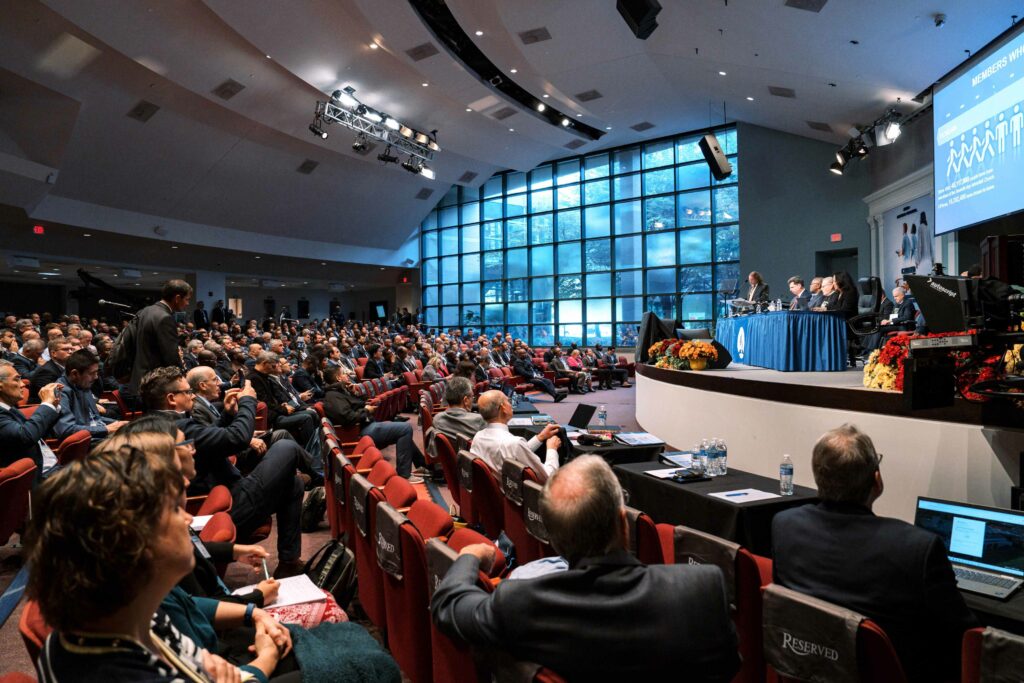
Members of the General Conference Executive Committee listen to David Trim, director of the GC Office of Archives, Statistics, and Research, as he presents the latest data on church membership. [Photo: Lucas Cardino / Adventist Media Exchange (CC BY 4.0)]
Moving Mission Forward
In the last section of his report, Köhler referenced Mission Refocus, an initiative of the GC to redirect more funds and resources to the worldwide mission field. This emphasis on frontline mission service has required financial adjustments at all church levels, he acknowledged, but it’s already rendering tangible results.
This new emphasis has resulted, among many other initiatives, in the reopening of the Baghdad Seventh-day Adventist Church in Iraq, which had been close since 2003. This was achieved thanks to a family deployed to serve in that area of the world, Köhler reported. “Mission Refocus is not a dream or a project anymore; it is a reality!” he said.
Three Mission Windows
Köhler then delved into what he called “three mission windows” present in every church region around the world. They include the 10/40 Window (a region of the world where most of the world’s population lives but where Christians are a minority), the Post-Christian Window, and the Urban Window.
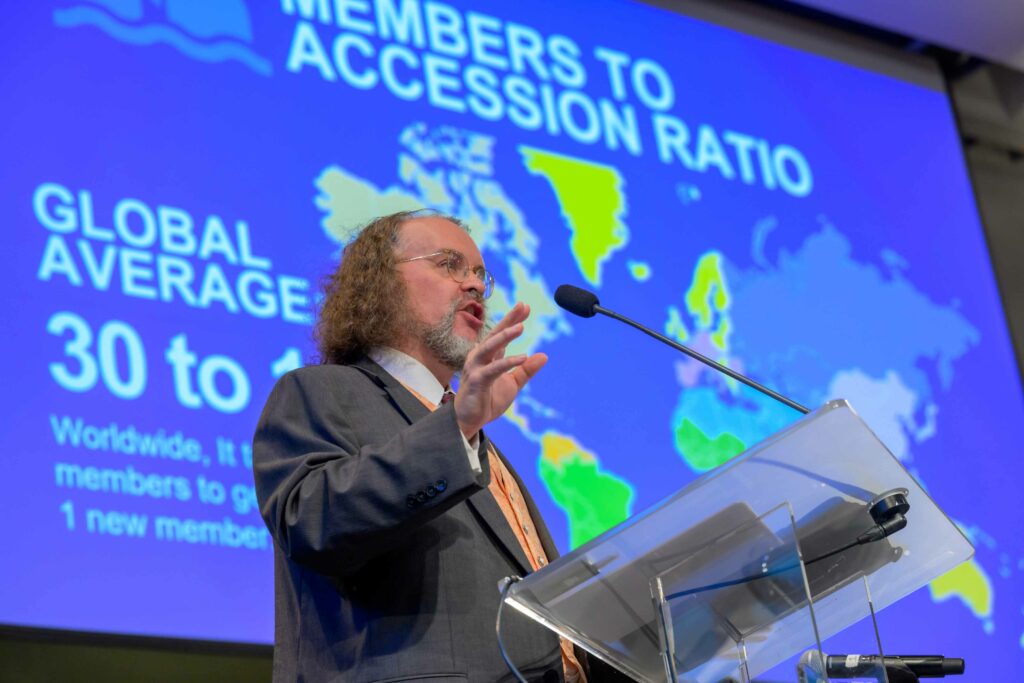
David Trim discusses the members to accession ratio, or how many members every church region needs to gain a new member. [Photo: Tor Tjeransen / Adventist Media Exchange (CC BY 4.0)]
He mentioned specific people groups around the world that represent a big challenge for Adventist mission, including the Hausa in Nigeria, the Bamar in Myanmar, and the Somali people in northern Somalia. He also singled out the Bengali in Bangladesh, the Mahratta in India, and the Northern Uzbek in Uzbekistan. All of them include millions in population, many of whom have never heard about Jesus and His truth.
Köhler also called church leaders’ attention to post-Christian nations affected by increasing secularism, including New Zealand, Czechia, and Greece. Among urban centers, he singled out Naples in Italy, with more than 21,000 residents per Adventist church member, Durban in South Africa; Buenos Aires in Argentina; and Guadalajara in Mexico.
“It is time to reorganize our priorities, our meetings, our agendas, our strategies, all our resources, and focus them on our mission,” Köhler said. “It is time to take on the most challenging places and people groups within our territories.”
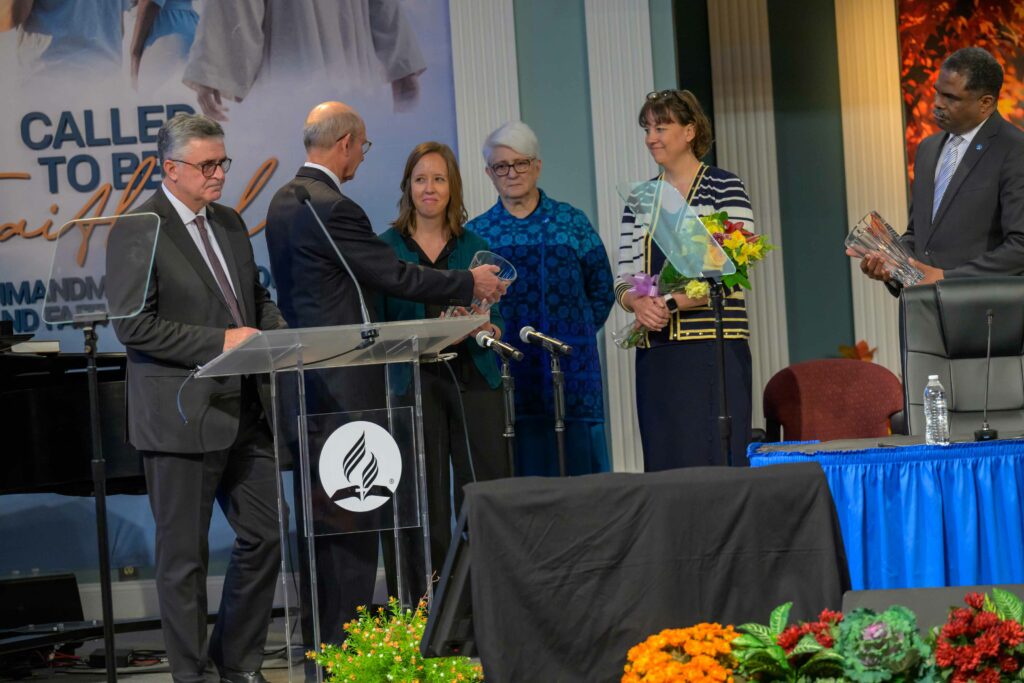
On behalf of the Roberts family, Stephanie Roberts Lewis received a recognition of the sacrifice for mission made by Gary Keith Roberts and his family. [Photo: Tor Tjeransen / Adventist Media Exchange (CC BY 4.0)]
Mission requires investing resources in it, Köhler emphasized. However, when we tackle our mission challenges, God will send the resources we need, Köhler said. “Money must follow the mission,” and not the other way around, he added. Thus, “we can move forward with boldness, trusting in the owner of the mission.”
Twenty-first-century church leaders need to relive the spirit of sacrifice of Adventism’s early pioneers, Köhler said. He shared that even now, the Adventist Church has faithful missionaries giving and even losing their lives in the mission field. “They are keeping alive the spirit of sacrifice in our days and motivating all of us to commit our best to the worldwide mission,” he said.
As an example of that “life commitment to mission,” Köhler introduced the family of Gary Roberts. Missionary pilot Roberts and his family dedicated their lives to mission in Papua, Indonesia. But it has been at a high cost, he acknowledged.
“First, they lost their son to malaria while in the mission field when he was still young,” Köhler said. “Later, Gary’s father, also a mission pilot, was killed in a plane crash while serving in the mission field. This past summer, Gary himself was faced with an inoperable brain tumor diagnosis. And yet, even in his battle with a terminal illness, Gary’s faith stood strong.”
Köhler reported that after Gary Roberts died on July 24, his brother Eric expressed his desire to replace him as a mission pilot. “He will be the third member of the Roberts family to dedicate his life to mission,” Köhler said.
With a special prayer for the Roberts family, Köhler closed his report. EXCOM members voted overwhelmingly to record receipt of the report.